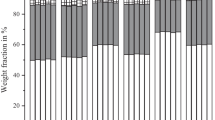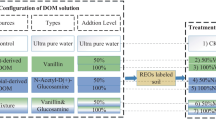Abstract
Background and aims
Rare earth element (REE) oxides serve as effective tracers to track aggregate dynamics. However, the impact of labeling and sieving processes on aggregate and organic matter dynamics remains uncertain. This study aimed to determine the effect of the labeling and sieving processes on soil aggregate and organic carbon dynamics.
Methods
Dry and wet sieved aggregates from a Japanese typical Andisol were labeled with REE oxides. REE oxides concentrations and soil organic carbon fractions were measured during the 28-day incubation period to calculate aggregate transformation paths and soil organic carbon dynamics.
Results
The findings demonstrated that REE oxides are effective tracers to track Andisol aggregate turnover. The labeling and sieving processes showed significant positive effect on aggregate turnover. During incubation, wet sieved macroaggregates displayed more transformation than dry sieved aggregates (5.26% ~ 7.24% vs. 11.03% ~ 12.81%), reflecting a higher turnover rate of macroaggregates resulting from wet sieving relative to dry sieving. Regarding organic carbon fractions, the labeling process significantly affected dissolved organic carbon (DOC), microbial biomass carbon (MBC), and free particulate organic matter (fPOM). Additionally, the degree of interference was linked to the sieving processes, with MBC and fPOM content significantly lower following wet sieving. This effect persisted during incubation, except for fPOM content, which exhibited a rapid increase accompanied by a decrease in occluded particulate organic matter (oPOM) content following the wet sieving method.
Conclusion
Our results demonstrate that the effects of labeling and sieving processes should be considered when analyzing the relationship between aggregate turnover and organic carbon with REE oxides tracers.








Similar content being viewed by others
Data availability
The datasets generated during the current study are available from the corresponding author on reasonable request.
References
Asano M, Wagai R (2014) Evidence of aggregate hierarchy at micro-to submicron scales in an allophanic Andisol. Geoderma 216:62–74. https://doi.org/10.1016/j.geoderma.2013.10.005
Bach EM, Hofmockel KS (2014) Soil aggregate isolation method affects measures of intra-aggregate extracellular enzyme activity. Soil Biol Biochem 69:54–62. https://doi.org/10.1016/j.soilbio.2013.10.033
Baumert VL, Forstner SJ, Zethof JH, Vogel C, Heitkötter J, Schulz S, Kögel-Knabner I, Mueller CW (2021) Root-induced fungal growth triggers macroaggregation in forest subsoils. Soil Biol Biochem 157:108244. https://doi.org/10.1016/j.soilbio.2021.108244
Batjes NH (1996) Total carbon and nitrogen in the soils of the world. Eur J Soil Sci 47(2):151–163. https://doi.org/10.1111/j.1365-2389.1996.tb01386.x
Blaud A, Menon M, van der Zaan B, Lair GJ, Banwart SA (2017) Effects of dry and wet sieving of soil on identification and interpretation of microbial community composition. Adv Agron 142:119–142. https://doi.org/10.1016/bs.agron.2016.10.006
Bottner P (1985) Response of microbial biomass to alternate moist and dry conditions in a soil incubated with 14C-and 15N-labelled plant material. Soil Biol Biochem 17:329–337. https://doi.org/10.1016/0038-0717(85)90070-7
Bronick CJ, Lal R (2005) Soil structure and management: a review. Geoderma 124:3–22. https://doi.org/10.1016/j.geoderma.2004.03.005
Brown RB, Kling GF, Cutshall NH (1981) Agricultural erosion indicated by 137Cs redistribution: II. Estimates of erosion rates. Soil Sci Soc Am J 45:1191–1197. https://doi.org/10.2136/sssaj1981.03615995004500060036x
Cambardella CA, Elliott ET (1993) Methods for physical separation and characterization of soil organic matter fractions. In: Brussaard L, Kooistra MJ (eds) Soil Structure/Soil Biota Interrelationships. Elsevier, Amsterdam, 449–457. https://doi.org/10.1016/B978-0-444-81490-6.50036-4
Dahlgren RA, Saigusa M, Ugolini FC (2004) The nature, properties and management of volcanic soils. Adv Agron 82:113–182. https://doi.org/10.1016/S0065-2113(03)82003-5
De Gryze S, Six J, Merckx R (2006) Quantifying water-stable soil aggregate turnover and its implication for soil organic matter dynamics in a model study. Eur J Soil Sci 57:693–707. https://doi.org/10.1111/j.1365-2389.2005.00760.x
Denef K, Six J, Bossuyt H, Frey SD, Elliott ET, Merckx R, Paustian K (2001) Influence of dry–wet cycles on the interrelationship between aggregate, particulate organic matter, and microbial community dynamics. Soil Biol Biochem 33:1599–1611. https://doi.org/10.1016/S0038-0717(01)00076-1
Elliott ET (1986) Aggregate structure and carbon, nitrogen, and phosphorus in native and cultivated soils. Soil Sci Soc Am J 50:627–633. https://doi.org/10.2136/sssaj1986.03615995005000030017x
Eswaran H, Van Den Berg E, Reich P (1993) Organic Carbon in Soils of the World. Soil Sci Soc Am J 57:192–194. https://doi.org/10.2136/sssaj1993.03615995005700010034x
Garrido E, Matus F (2012) Are organo-mineral complexes and allophane content determinant factors for the carbon level in Chilean volcanic soils? CATENA 92:106–112. https://doi.org/10.1016/j.catena.2011.12.003
Halder M, Liu S, Zhang ZB, Guo ZC, Peng XH (2022) Effects of organic matter characteristics on soil aggregate turnover using rare earth oxides as tracers in a red clay soil. Geoderma 421:115908. https://doi.org/10.1016/j.geoderma.2022.115908
Haynes RJ (2000) Interactions between soil organic matter status, cropping history, method of quantification and sample pretreatment and their effects on measured aggregate stability. Biol Fertility Soils 30:270–275. https://doi.org/10.1007/s003740050002
Huygens D, Boeckx P, Van Cleemput O, Oyarzun C, Godoy R (2005) Aggregate and soil organic carbon dynamics in South Chilean Andisols. Biogeosciences 2:159–174. https://doi.org/10.5194/bg-2-159-2005,2005
Jager G, Bruins EH (1975) Effect of repeated drying at different temperatures on soil organic matter decomposition and characteristics, and on the soil microflora. Soil Biol Biochem 7:153–159. https://doi.org/10.1016/0038-0717(75)90013-9
Jenkinson DS, Powlson DS (1976) The effects of biocidal treatments on metabolism in soil—V: A method for measuring soil biomass. Soil Biol Biochem 8:209–213. https://doi.org/10.1016/0038-0717(76)90005-5
Joergensen RG, Mueller T (1996) The fumigation-extraction method to estimate soil microbial biomass: calibration of the kEN value. Soil Biol Biochem 28:33–37. https://doi.org/10.1016/0038-0717(95)00101-8
Kemper WD, Rosenau RC (1986) Aggregate Stability and Size Distribution. In Methods of Soil Analysis, A. Klute (Ed.). https://doi.org/10.2136/sssabookser5.1.2ed.c17
Le Bissonnais Y (2016) Aggregate stability and assessment of soil crustability and erodibility: I. Theory and methodology. Eur J Soil Sci 47:425–437. https://doi.org/10.1111/j.1365-2389.1996.tb01843.x
Leij FJ, Ghezzehei TA, Or D (2002) Modeling the dynamics of the soil pore-size distribution. Soil Tillage Res 64:61–78. https://doi.org/10.1016/S0167-1987(01)00257-4
Liu S, Guo ZC, Pan YB, Zhang LL, Hallett PD, Peng XH (2019) Rare earth oxides for labelling soil aggregate turnover: Impacts of soil properties, labelling method and aggregate structure. Geoderma 351:36–48. https://doi.org/10.1016/j.geoderma.2019.05.015
Lund V, Goksøyr J (1980) Effects of water fluctuations on microbial mass and activity in soil. Microb Ecol 6:115–123. https://doi.org/10.1007/BF02010550
Morris EK, Morris D, Vogt S, Gleber S, Bigalke M, Wilcke W, Rillig MC (2019) Visualizing the dynamics of soil aggregation as affected by arbuscular mycorrhizal fungi. ISME J 13:1639–1646. https://doi.org/10.1038/s41396-019-0369-0
Nahidan S, Nourbakhsh F (2018) Distribution pattern of amidohydrolase activities among soil aggregates: Effect of soil aggregates isolation methods. Appl Soil Ecol 125:250–256. https://doi.org/10.1016/j.apsoil.2018.02.004
Oades JM, Waters AG (1991) Aggregate Hierarchy in Soils. Soil Research 29:815–828. https://doi.org/10.1071/SR9910815
Olmez I, Pink FX, Wheatcroft RA (1994) New particle-labeling technique for use in biological and physical sediment transport studies. Environ Sci Technol 28:1487–1490. https://doi.org/10.1021/es00057a017
Peng X, Zhu Q, Zhang Z, Hallett PD (2017) Combined turnover of carbon and soil aggregates using rare earth oxides and isotopically labelled carbon as tracers. Soil Biol Biochem 109:81–94. https://doi.org/10.1016/j.soilbio.2017.02.002
Plante AF, Feng Y, McGill WB (2002) A modeling approach to quantifying soil macroaggregate dynamics. Can J Soil Sci 82:181–190. https://doi.org/10.4141/S01-024
Plante AF, McGill WB (2002) Soil aggregate dynamics and the retention of organic matter in laboratory-incubated soil with differing simulated tillage frequencies. Soil Tillage Res 66:79–92. https://doi.org/10.1016/S0167-1987(02)00015-6
Rahman MT, Liu S, Guo ZC, Zhang ZB, Peng XH (2019) Impacts of residue quality and N input on aggregate turnover using the combined 13C natural abundance and rare earth oxides as tracers. Soil Tillage Res 189:110–122. https://doi.org/10.1016/j.still.2019.01.005
Ritchie JC, McHenry JR (1990) Application of radioactive fallout cesium-137 for measuring soil erosion and sediment accumulation rates and patterns: A review. J Environ Qual 19:215–233. https://doi.org/10.2134/jeq1990.00472425001900020006x
Sainju UM (2006) Carbon and nitrogen pools in soil aggregates separated by dry and wet sieving methods. Soil Sci 171(12):937–949. https://doi.org/10.1097/01.ss0000228062.30958.5a
Six J, Bossuyt H, Degryze S, Denef K (2004) A history of research on the link between (micro) aggregates, soil biota, and soil organic matter dynamics. Soil Tillage Res 79:7–31. https://doi.org/10.1016/j.still.2004.03.008
Six J, Elliott ET, Paustian K, Doran JW (1998) Aggregation and soil organic matter accumulation in cultivated and native grassland soils. Soil Sci Soc Am J 62:1367–1377. https://doi.org/10.2136/sssaj1998.03615995006200050032x
Snyder JD, Trofymow JA (1984) A rapid accurate wet oxidation diffusion procedure for determining organic and inorganic carbon in plant and soil samples. Commun Soil Sci Plant Anal 15:587–597. https://doi.org/10.1080/00103628409367499
Sørensen LH (1974) Rate of decomposition of organic matter in soil as influenced by repeated air drying-rewetting and repeated additions of organic material. Soil Biol Biochem 6:287–292. https://doi.org/10.1016/0038-0717(74)90032-7
Staff SS (2014) Keys to Soil Taxonomy. Natural Resources Conservation Service, Washington (DC).
Staricka JA, Allmaras RR, Nelson WW, Larson WE (1992) Soil aggregate longevity as determined by the incorporation of ceramic spheres. Soil Sci Soc Am J 56:1591–1597. https://doi.org/10.2136/sssaj1992.03615995005600050042x
Tyler G (2004) Rare earth elements in soil and plant systems-A review. Plant Soil 267:191–206. https://doi.org/10.1007/s11104-005-4888-2
Van Gestel M, Ladd JN, Amato M (1991) Carbon and nitrogen mineralization from two soils of contrasting texture and microaggregate stability: influence of sequential fumigation, drying and storage. Soil Biol Biochem 23:313–322. https://doi.org/10.1016/0038-0717(91)90185-M
Wagai R, Kishimoto-Mo AW, Yonemura S, Shirato Y, Hiradate S, Yagasaki Y (2013) Linking temperature sensitivity of soil organic matter decomposition to its molecular structure, accessibility, and microbial physiology. Glob Change Biol 19:1114–1125. https://doi.org/10.1111/gcb.12112
Wallbrink PJ, Murray AS (1993) Use of fallout radionuclides as indicators of erosion processes. Hydrol Process 7:297–304. https://doi.org/10.1002/hyp.3360070307
Wang D, Anderson DW (1998) Direct measurement of organic carbon content in soils by the Leco CR-12 carbon analyzer. Commun Soil Sci Plant Anal 29:15–21. https://doi.org/10.1080/00103629809369925
Wang Y, Asano M, Gong W, Jiang Q, Teni G, Tamura K (2023) Rare Earth Oxides for Labeling an Andisol Aggregate Turnover: Optimization, Verification, and Distribution.J Soil Sci Plant Nutr 23, 4168–4182. https://doi.org/10.1007/s42729-023-01334-z
Zhang XC, Friedrich JM, Nearing MA, Norton LD (2001) Potential use of rare earth oxides as tracers for soil erosion and aggregation studies. Soil Sci Soc Am J 65:1508–1515. https://doi.org/10.2136/sssaj2001.6551508x
Zsolnay Á (2003) Dissolved organic matter: artefacts, definitions, and functions. Geoderma 113:187–209. https://doi.org/10.1016/S0016-7061(02)00361-0
Acknowledgements
We thank Prof.Wagai Rota for the management and maintenance of long-term field experiments, and our lab colleagues for the assistance of soil sampling and analyses. We would like to thank the China Scholarship Council for support this work through the award of a fellowship to Dr. Wang YK (grant no.202008610192).
Funding
This work was supported by Japan Society for the Promotion of Science, Program for Grant-in-Aid for Scientific Research (B) 21H02086 and Institute of Geographic Sciences and Natural Resources Research, Chinese Academy of Sciences (grant no. E3V30020YZ).
Author information
Authors and Affiliations
Contributions
Y.K-W. & A-M. – Conceptualization, Investigation, Formal Analysis, Writing, Funding acquisition, Original Draft, Visualization; Q-J. – Investigation; Y.Y-H – Review & Editing, Supervision, Funding Acquisition, Project Administration; K-T. – Supervision, Review & Editing.
All authors read and approved the final manuscript.
Corresponding authors
Ethics declarations
Conflict of interest
The authors declare that the research was conducted in the absence of any commercial or financial relationship that could be construed as a potential conflict of interest.
Additional information
Responsible Editor: Timothy J. Fahey.
Publisher's Note
Springer Nature remains neutral with regard to jurisdictional claims in published maps and institutional affiliations.
Rights and permissions
Springer Nature or its licensor (e.g. a society or other partner) holds exclusive rights to this article under a publishing agreement with the author(s) or other rightsholder(s); author self-archiving of the accepted manuscript version of this article is solely governed by the terms of such publishing agreement and applicable law.
About this article
Cite this article
Wang, Y., Maki, A., Huang, Y. et al. Effect of rare earth oxide labeling and sieving processes on Andisol aggregate turnover and organic carbon dynamics. Plant Soil (2024). https://doi.org/10.1007/s11104-024-06514-z
Received:
Accepted:
Published:
DOI: https://doi.org/10.1007/s11104-024-06514-z




